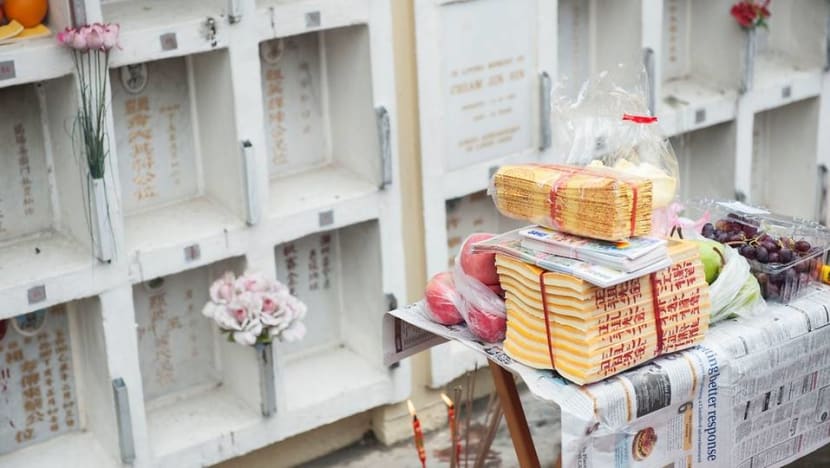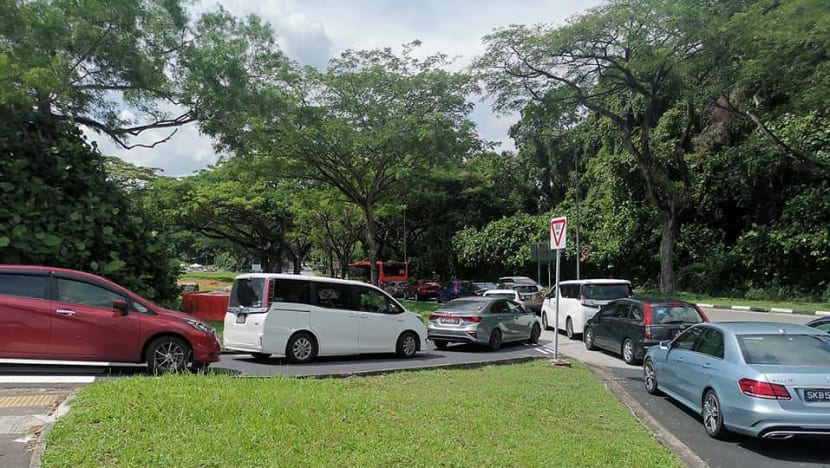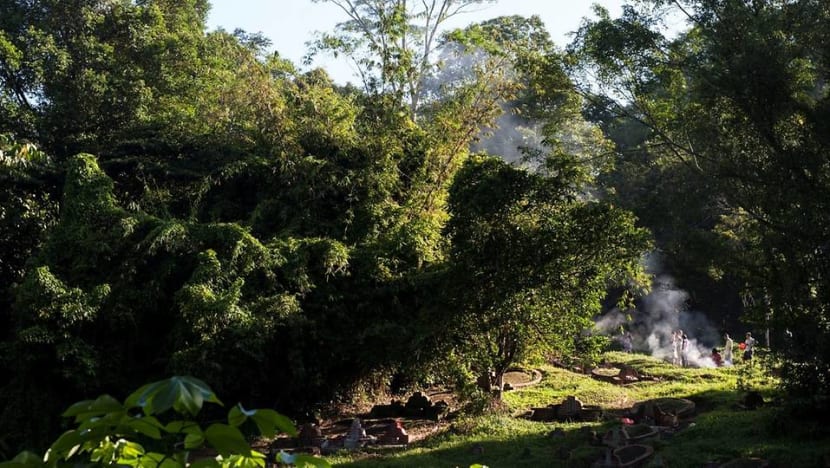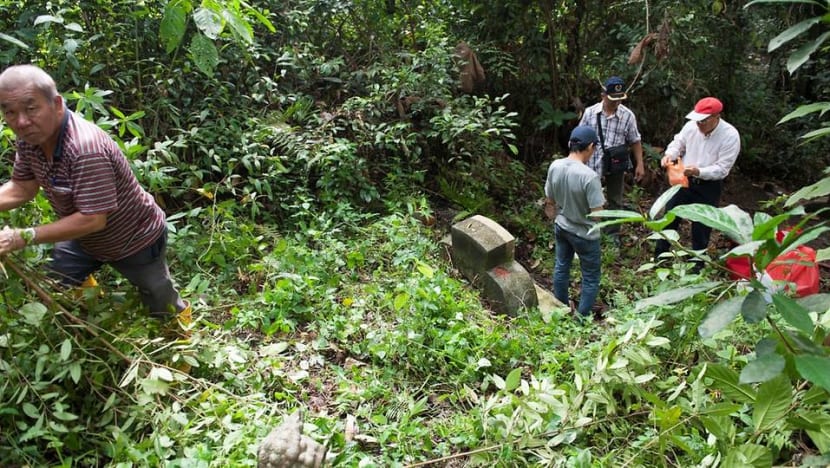commentary Commentary
Commentary: Why crowds will keep heading to the cemeteries and columbaria during Qing Ming
Every year, Chinese Singaporeans engage in a frenzy of tomb-sweeping, offering-making and effigy-burning. Qing Ming means more than just filial piety, says University of Liverpool’s Terence Heng.

Offerings for a loved one who has passed on. (Photo: Terence Heng)
SINGAPORE: Thanks to lockdowns, I’ve had the opportunity to review my archive of images and videos I created as part of a research project into the social and cultural life of Bukit Brown Cemetery.
This was no mean feat, as the terabytes of data had threatened to bring my puny laptop to its knees.
While drinking Milo and waiting for files to load, I chanced upon the first video I ever took of Bukit Brown as a researcher.
It was about 5am in the morning on a cold, rainy first day of Qing Ming. Cars had started to stream slowly into the cemetery, parking wherever there was space.
People alighted, balancing bags of paper offerings, torchlights and umbrellas, slowing inching their way through the rain, wind and dark. I thought to myself, “that’s dedication”.
Every year, Chinese Singaporeans engage in a burst of activity during Qing Ming. A ritual that involves the visiting and cleaning of tombs, Qing Ming is commonly associated with the practice of filial piety. One does it because one is a good descendant.
Commentary: Finding filial duty, spiritual charity in Hungry Ghost Festival rituals
TRAFFIC JAMS AND TOMB SWEEPING
Singapore’s high population density creates additional logistical challenges to performing Qing Ming rituals.
The sudden influx of families to columbaria and cemeteries often means long queues of cars and people all jostling for a slot to pay their respects – with last week’s long queue of cars waiting to get into Mandai Crematorium being little of an exception.

It is not uncommon to park further away and trudge along the sidewalk, all while trying to carry large plastic bags of offerings, often looking like one just looted the local Taobao warehouse.
Might it have been the perfect storm when some columbaria were closed on weekends and public holidays since end-March and people had leave to clear before the new financial year?
The National Environmental Agency and other authorities have had a difficult task of balancing people’s needs and pandemic physical distancing measures.
Regardless, recent news reports have shown how challenging it is when large numbers swarm a small space at the same time.
Commentary: The dead need a place too in land-scarce Singapore
WHY GO AT ALL?
In the age of the Internet, with #funeral and zoom-everything, and especially now with COVID-19 restrictions, why are people still undertaking the arduous task of Qing Ming?
With the range of guidelines advising people to restrict visiting family sizes to four, refrain from bringing elderly family members and avoid joss paper burning in the columbaria and more, would it not be easier to do something at home?
Some might point to the idea of risk management – that one does not wish to anger one’s ancestors by ignoring them, and hence a physical visit to their tombs during Qing Ming becomes an obligation and a way to avoid misfortune.

Others will note that Qing Ming is “special”, like Mother’s or Father’s Day – it is the one chance of the year, other than Chinese New Year, that families gather to collectively engage in an activity.
Both of these reasons are valid and have social resonance. The belief in ancestral spirits and their ability to affect our lives still holds significant sway among many, who see the fates and fortunes of the living intertwined with the well-being of the dead.
REINFORCING IDENTITIES
Beyond religious practices and beliefs, Qing Ming is an example of how certain rituals are important social events in which individuals engage in different kinds of labour, or work – emotional, spiritual and familial.
We know from both scholarly and media accounts that the act of collective remembrance of one’s ancestors through grave visitations and upkeep is a common and shared phenomenon across cultures. It is also not uncommon to see families around the world leaving favourite foods and decorations at their loved one’s resting place.
What can we make of this? For one, it suggests that such rituals are not just done as a religious obligation, they are an expression and reinforcement of multiple levels of identities.
Mnemonic acts, those done to remember and memorialise, enable society to continue to perpetuate the individual identities of those who have died.
The most obvious of these would be of famous or political figures, but even ensuring the names on a tombstone are visible is a way to ensure a person is still a person.
PART OF THE FAMILY
Collective identities, especially that of kinship, are similarly emphasised and perpetuated in mnemonic acts. By tending to a grave, making offerings, and simply spending time with family there, Qing Ming reinforces what it means to be part of a collective group.

During my research in Bukit Brown, I encountered a Chinese Indonesian gentleman, who at the age of 74 was able and willing to climb the steep and muddy slopes of the cemetery (in business dress shoes) every Qing Ming so as to make offerings and hire grave keepers to clear his ancestor’s tomb of weeds and vegetation.
I marvelled at his agility (as well as the yummy snacks he gifted to everyone afterwards), but I also realised how important it was to him that he came back every year to re-establish his relationship with his ancestor.
His presence at the grave, however brief, was an affirmation of family and a cementing of connections.
Commentary: Taking obituary photos and the difference between death and dying
EMOTIONAL LABOUR, A HERITAGE OF DOING
As such, when individuals perform mnemonic acts that re-connect to their histories, they are also in a small way making their heritage real and tangible, even if it does not feel like it.
Occasions like Qing Ming remind us of our past, which in turn is the foundation for our present, and a cornerstone for the future.
People are aware of this link, consciously or subconsciously. Over the years, I have seen in both a professional and personal capacity, the care and concern that individuals show when cleaning tombs.
Whether it is gingerly wiping the deceased’s photograph, re-painting engraved words, or making design decisions when renovating and rejuvenating tombstones, individuals often pour their emotions into this work. We do this not just for our ancestors, but also for ourselves.
So the next time you find yourself at a cemetery or columbarium, whether on Qing Ming or another important date, take the time to think about how being there connects you to a wider world, and how the best way to care for oneself is to care for others.
Terence Heng is a senior lecturer in Sociology at the University of Liverpool, UK, where he is also an associate at the Centre for Architecture and the Visual Arts. His latest books are Of Gods, Gifts and Ghosts: Spiritual Places in Urban Spaces (Routledge, 2020) and Diasporas, Weddings and the Trajectories of Ethnicity (Routledge, 2020).












